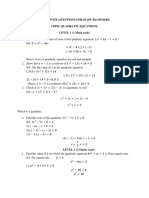Solving Rational Equations
Solving Rational Equations
Uploaded by
Danrie CaminadeCopyright:
Available Formats
Solving Rational Equations
Solving Rational Equations
Uploaded by
Danrie CaminadeOriginal Description:
Copyright
Available Formats
Share this document
Did you find this document useful?
Is this content inappropriate?
Copyright:
Available Formats
Solving Rational Equations
Solving Rational Equations
Uploaded by
Danrie CaminadeCopyright:
Available Formats
SOLVING RATIONAL EQUATIONS
Example 1
3 4
Solve for x if 𝑥−1 = 𝑥+2
Solution:
Multiply both sides by the LCD which is (𝑥 − 1)(𝑥 + 2). Simplify the equation to have 3(𝑥 + 2) = 4(𝑥 − 1). This is done
only when the equation involves only one term in each side of the equation. Note that this process is the same as cross
multiplying. You have:
3(𝑥 + 2) = 4(𝑥 − 1)
3𝑥 + 6 = 4𝑥 − 4
6 + 4 = 4𝑥 − 3𝑥
10 = 𝑥
Hence, x= 10
Example 2
1 2
Find the solution of − =1
𝑥+1 𝑥+2
Solution:
The LCD is (x+1)(x+2). Multiplying both sides of the equation by the LCD yields
3(𝑥 + 2) − 2(𝑥 + 1) = (𝑥 + 1)(𝑥 + 2)
3𝑥 + 6 − 2𝑥 − 2 = 𝑥 2 + 3𝑥 + 2
𝑥 + 4 = 𝑥 2 + 3𝑥 + 2
0 = 𝑥 2 + 2𝑥 − 2
or 𝑥 2 + 2𝑥 − 2 = 0
Using the quadratic formula,
−𝑏 ± √𝑏 − 4𝑎𝑐
𝑥=
2𝑎
−2 ± √4 − 4(1)(−2) −2 ± √12 2(−1 ± 3)
𝑥= = = = −1 ± √3
2 2 2
Hence, the solution set is {−1 − √3, −1 + √3}.
Example 3
2 1
Solve for y in the equation = − 3.
𝑦 𝑦−2
Solution:
Multiplying both sides by the LCD, which is𝑦(𝑦 − 2),yields Using quadratic formula,
−𝑏±√𝑏−4𝑎𝑐
2(𝑦 − 2) = 𝑦 − 3(𝑦)(𝑦 − 2) 𝑥= 2𝑎
5±√25−4(3)(−4)
2𝑦 − 4 = 𝑦 − 3𝑦 2 + 6𝑦 𝑥= 2(3)
2𝑦 − 4 = −3𝑦 2 + 7𝑦 𝑥 = 5 ± √73
0 = −3𝑦 2 + 5y + 4 Hence, the solution set is {5 − √73, 5 + √73}
or 3𝑦 2 − 5𝑦 − 4 = 0
You might also like
- Mathematics P2 Grade 11 MEMO June 2023Document9 pagesMathematics P2 Grade 11 MEMO June 2023Shriddhi Maharaj100% (1)
- Application Letter BSHMDocument1 pageApplication Letter BSHMDanrie Caminade89% (9)
- Maths Ec Last Push P1Document56 pagesMaths Ec Last Push P1mswelimaria97100% (2)
- Mathematics Grade 10 Paper 1 November Exam 2022 MemoDocument9 pagesMathematics Grade 10 Paper 1 November Exam 2022 Memotonnymashabani02No ratings yet
- TL201 - TMS3725 Assignment 03 2022 - PDFDocument14 pagesTL201 - TMS3725 Assignment 03 2022 - PDFMbiselo TshabadiraNo ratings yet
- Algebra 2 - 9th Grade Book PDFDocument1,018 pagesAlgebra 2 - 9th Grade Book PDFLUIS SANTIAGO SOLORZANO QUINTANILLANo ratings yet
- Chapter 11 - Coordinate Geometry and GraphsDocument54 pagesChapter 11 - Coordinate Geometry and GraphsAhmad MahmoodNo ratings yet
- As Pure Maths Revision NotesDocument15 pagesAs Pure Maths Revision NotesAbd Elrhman MohamedNo ratings yet
- Modulo Art Small Division Meet PDFDocument3 pagesModulo Art Small Division Meet PDFDanrie Caminade0% (3)
- Lecture 7 ExponentDocument8 pagesLecture 7 Exponentrahman241abdurNo ratings yet
- Quadratic EquationDocument6 pagesQuadratic EquationDanielNo ratings yet
- SOLUCIONARIODocument8 pagesSOLUCIONARIOLuz mery Juárez chinchaiNo ratings yet
- 2023 GRADE 11 Memo - Mopani West Term 4 Test 5Document7 pages2023 GRADE 11 Memo - Mopani West Term 4 Test 5lebepetumelo9No ratings yet
- GRADE 11 2024 MATHS Memo - Mopani West Term 3 Test 3Document7 pagesGRADE 11 2024 MATHS Memo - Mopani West Term 3 Test 3nthatimasetlhaNo ratings yet
- 2023 Memo - Mopani West Term 3 Test-2Document9 pages2023 Memo - Mopani West Term 3 Test-2tiyanimmola26No ratings yet
- Quadratic EquationsDocument19 pagesQuadratic EquationsPaula FanaNo ratings yet
- Implicit Differentiation 5Document7 pagesImplicit Differentiation 5chilekwamichael26No ratings yet
- 2024 Grade 12 Term 1 MemoDocument9 pages2024 Grade 12 Term 1 Memoboyqdollars939No ratings yet
- Level Wise Questions For Slow Bloomers Topic Quadratic Equations: LEVEL 1 (1 Mark Each)Document7 pagesLevel Wise Questions For Slow Bloomers Topic Quadratic Equations: LEVEL 1 (1 Mark Each)hljghjhjNo ratings yet
- GR 11 June 2023 P1 (PLC) MemoDocument10 pagesGR 11 June 2023 P1 (PLC) MemoKynG Beat[s] ZANo ratings yet
- Wa0018.Document21 pagesWa0018.muktanaik0106No ratings yet
- MAT 1100 Inequalities - 2020Document15 pagesMAT 1100 Inequalities - 2020Nathan MulunguNo ratings yet
- Algebra Seminario 1Document17 pagesAlgebra Seminario 1RobertPazCNo ratings yet
- Memo Maths Grade 11 Test 1 March 2024Document5 pagesMemo Maths Grade 11 Test 1 March 2024abuttieymadumaneNo ratings yet
- As Pure Maths Revision Notes: 1 SurdsDocument14 pagesAs Pure Maths Revision Notes: 1 SurdsM.Usama MustafaNo ratings yet
- WBHS GR 11 Nov Exam Paper 1 2019 MemoDocument6 pagesWBHS GR 11 Nov Exam Paper 1 2019 Memompumezogcanga04No ratings yet
- Updated Memo For Test 1 SubmissionDocument7 pagesUpdated Memo For Test 1 Submissionkatlegonicole945No ratings yet
- CIS - LP - Simultaneous - Linear - and - Quadratic - Equations 2 - WK10 - Y11 - V2Document8 pagesCIS - LP - Simultaneous - Linear - and - Quadratic - Equations 2 - WK10 - Y11 - V2myeboockNo ratings yet
- 2020 LP Term-1-Test-Maths-Grd-11-MgDocument7 pages2020 LP Term-1-Test-Maths-Grd-11-MgjupitermametjeNo ratings yet
- Integration by Trigonometric SubstitutionDocument6 pagesIntegration by Trigonometric Substitutions.mangan.emarieNo ratings yet
- MTK PmintanDocument15 pagesMTK PmintanDange LionNo ratings yet
- Grade 12 Chapter 1 (Part 1) 2Document27 pagesGrade 12 Chapter 1 (Part 1) 2Sai ThiHaNo ratings yet
- Quadratic EquationsDocument12 pagesQuadratic EquationsRaymondNo ratings yet
- Chapter 3 Solutions of EquationsDocument16 pagesChapter 3 Solutions of Equations123owisNo ratings yet
- As Pure Maths Revision NotesDocument14 pagesAs Pure Maths Revision NotesSundarNo ratings yet
- Partial Fractions QuizDocument6 pagesPartial Fractions Quizmugumeaugustine66No ratings yet
- Exam 1 SolutionDocument2 pagesExam 1 Solutionowronrawan74No ratings yet
- Maths Ec Last Push p1Document57 pagesMaths Ec Last Push p1vunweshivambe35No ratings yet
- ACET December 2023 SolutionDocument10 pagesACET December 2023 Solutionomkarsutar9440No ratings yet
- Resolução - 4 Exercícios de Integrais Indefinidas - 2021Document18 pagesResolução - 4 Exercícios de Integrais Indefinidas - 2021Aluno MeloNo ratings yet
- PM-Simultaneous Equations PDFDocument4 pagesPM-Simultaneous Equations PDFfifak44760No ratings yet
- Solucionario de La Prueba de Desarrollo N°01-B-Cálculo Iii: Separando VariablesDocument6 pagesSolucionario de La Prueba de Desarrollo N°01-B-Cálculo Iii: Separando VariablesFrank JDiazNo ratings yet
- MSI Calculus MemosDocument34 pagesMSI Calculus Memoslulamangwenya67No ratings yet
- Matematik Tambahan: Modul Mas (Minimum Adequate Syllabus) SPM 2019Document37 pagesMatematik Tambahan: Modul Mas (Minimum Adequate Syllabus) SPM 2019Jinny NeutrollNo ratings yet
- Chapter 3 Applications of Double IntegralDocument14 pagesChapter 3 Applications of Double IntegralElizander GalasiNo ratings yet
- A3-Solution, 5,1 3Document16 pagesA3-Solution, 5,1 3ahmed.w.nawarNo ratings yet
- 3.1 Quadratic Equation and Expression MsDocument10 pages3.1 Quadratic Equation and Expression MsethankinangaNo ratings yet
- ACET November 2022 - SolutionDocument12 pagesACET November 2022 - Solutionvarun chittoriaNo ratings yet
- Revolution SolidDocument5 pagesRevolution SolidlpzpiscisNo ratings yet
- The Order of Operations (PEMDAS) : Parentheses or or - Exponents 5)Document82 pagesThe Order of Operations (PEMDAS) : Parentheses or or - Exponents 5)jack barensNo ratings yet
- Mathematics BookletDocument447 pagesMathematics BookletmageronatashaNo ratings yet
- TEMA 6 Longitud de ArcoDocument4 pagesTEMA 6 Longitud de Arcowilkinso alvarez anayaNo ratings yet
- Math 9 Pakopya Sa Lecture NBDocument1 pageMath 9 Pakopya Sa Lecture NBenrickolago17No ratings yet
- Worksheet (HWK) For Chapter 1Document1 pageWorksheet (HWK) For Chapter 1Mohammed Abdel-FattahNo ratings yet
- Algebra Pre Test Solutions Cal 1 ModuleDocument8 pagesAlgebra Pre Test Solutions Cal 1 Modulekyledarbymanalo1437No ratings yet
- Answer Key Year 9 Midyear Exam Study Guide Part 1Document3 pagesAnswer Key Year 9 Midyear Exam Study Guide Part 1hamood.aqeel313kingNo ratings yet
- Adma G.C.E P1 2020 SolutionsDocument11 pagesAdma G.C.E P1 2020 SolutionsChikuta ShingaliliNo ratings yet
- Quadratic FunctionsDocument6 pagesQuadratic FunctionsDeadly ChillerNo ratings yet
- Latihan Soal Persamaan Dan PertidaksamaanDocument6 pagesLatihan Soal Persamaan Dan Pertidaksamaanana Kusumaning WNo ratings yet
- Chapter 2 Quadratic FunctionsDocument20 pagesChapter 2 Quadratic FunctionsLIM HONG MINGNo ratings yet
- JEE Main 2021 Question Paper Maths August 26 Shift 1Document8 pagesJEE Main 2021 Question Paper Maths August 26 Shift 1Amit SharmaNo ratings yet
- Calculo VectorialDocument17 pagesCalculo VectorialGomez Hernandez Jorge JavierNo ratings yet
- 10+2 Level Mathematics For All Exams GMAT, GRE, CAT, SAT, ACT, IIT JEE, WBJEE, ISI, CMI, RMO, INMO, KVPY Etc.From Everand10+2 Level Mathematics For All Exams GMAT, GRE, CAT, SAT, ACT, IIT JEE, WBJEE, ISI, CMI, RMO, INMO, KVPY Etc.No ratings yet
- (Name of School) : Ma. Monina L. PatoltolDocument2 pages(Name of School) : Ma. Monina L. PatoltolDanrie CaminadeNo ratings yet
- Documentations For Brigada EskwelaDocument34 pagesDocumentations For Brigada EskwelaDanrie CaminadeNo ratings yet
- HM Project FormatDocument1 pageHM Project FormatDanrie CaminadeNo ratings yet
- Activity 10 Earthquake Drill: What Did I Do?Document1 pageActivity 10 Earthquake Drill: What Did I Do?Danrie CaminadeNo ratings yet
- Kra 1-Content Knowledge and Pedagogy Objective1. Applied Knowledge and Content Within and Across CurriculumDocument13 pagesKra 1-Content Knowledge and Pedagogy Objective1. Applied Knowledge and Content Within and Across CurriculumDanrie CaminadeNo ratings yet
- Solving Rational InequalitiesDocument1 pageSolving Rational InequalitiesDanrie CaminadeNo ratings yet
- Solving Rational InequalitiesDocument2 pagesSolving Rational InequalitiesDanrie Caminade0% (1)
- Intermediate Algebra Pointers: Powers and RootsDocument29 pagesIntermediate Algebra Pointers: Powers and Rootscj100% (1)
- Simpson's RuleDocument7 pagesSimpson's RuleRomulo Bartolome JrNo ratings yet
- Solving Neq1Document6 pagesSolving Neq1SAYID MABRUR RABBANI AL BABNo ratings yet
- P1 Jan 2020 ERDocument11 pagesP1 Jan 2020 ERIshy HereNo ratings yet
- Release Questions CSTDocument27 pagesRelease Questions CSTapi-133916648No ratings yet
- 4-6 Practice: The Quadratic Formula and The DiscriminantDocument1 page4-6 Practice: The Quadratic Formula and The Discriminantasdfasdfasdfasdfasdf0% (1)
- Activity SheetsDocument2 pagesActivity SheetsGary NugasNo ratings yet
- Mathematics (Mid Term) Time:1Hr 30mins Class:X Mm:40 General InstructionsDocument6 pagesMathematics (Mid Term) Time:1Hr 30mins Class:X Mm:40 General InstructionsFERA Future electronics and research administrationNo ratings yet
- Revision Guide Fp1Document163 pagesRevision Guide Fp1TomNguyen100% (1)
- University of Northern Philippines: Technology For Teaching and Learning 1Document13 pagesUniversity of Northern Philippines: Technology For Teaching and Learning 1rafaelmariahanne2029No ratings yet
- Worksheet 1 On Quadratic Equation. GRD 10Document2 pagesWorksheet 1 On Quadratic Equation. GRD 10Rakshith100% (1)
- Padhle Ebook - Previous 10 Year Question Papers With Solutions 2011-20 - Class 10 MathsDocument528 pagesPadhle Ebook - Previous 10 Year Question Papers With Solutions 2011-20 - Class 10 MathsKanak TiwariNo ratings yet
- de Moivres TheoremDocument18 pagesde Moivres TheoremAbdullah SaeedNo ratings yet
- CBSE Class 10 Maths Paper Solution 2011Document29 pagesCBSE Class 10 Maths Paper Solution 2011SantanuNo ratings yet
- Csec Add Maths May 2016Document29 pagesCsec Add Maths May 2016Joshua JagroopNo ratings yet
- Integration Using Partial Fractions: P X P X P X X X X X X XDocument7 pagesIntegration Using Partial Fractions: P X P X P X X X X X X XEviaNo ratings yet
- Quadratic Equations DPP 1666087837458Document2 pagesQuadratic Equations DPP 1666087837458rohanvillain1992No ratings yet
- 1587e23b-d5d2-4e3a-878e-4d96dd68d574-1709723366899-4102576142422223Document229 pages1587e23b-d5d2-4e3a-878e-4d96dd68d574-1709723366899-4102576142422223cidayax832No ratings yet
- Practice gr10 (2022-2023)Document293 pagesPractice gr10 (2022-2023)Lala Jafarova100% (1)
- Maths (Age Problems)Document22 pagesMaths (Age Problems)Saikat ChakrabortyNo ratings yet
- Polynomials Roots InvestigationDocument6 pagesPolynomials Roots InvestigationMadison HalesNo ratings yet
- TQ Q1 Mathematics 9-Bryan-HidalgoDocument6 pagesTQ Q1 Mathematics 9-Bryan-HidalgoJovie Erma AtonNo ratings yet
- Eulogio T. Catalan, JR., MBADocument140 pagesEulogio T. Catalan, JR., MBAjuncatalanNo ratings yet
- Formulas and Properties 9th GradeDocument4 pagesFormulas and Properties 9th Gradedgjdf hgjhdgNo ratings yet
- UCE Book 4Document134 pagesUCE Book 4Ssonko Martin100% (1)
- Class X - Maths Test (ch-1-4)Document2 pagesClass X - Maths Test (ch-1-4)Akshita KambojNo ratings yet
- Covid Project Jamaica PDFDocument5 pagesCovid Project Jamaica PDFDaniel RaphaelNo ratings yet

































































































